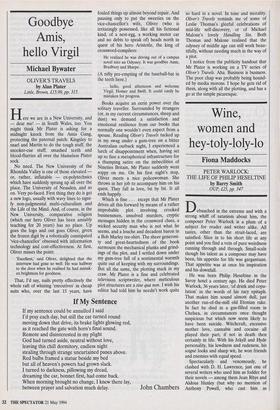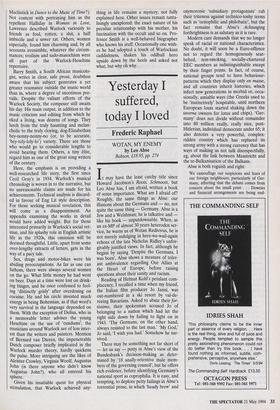Wine, women and hey-toly-loly-lo
Fiona Maddocks
PETER WARLOCK: THE LIFE OF PHILIP HESELTINE by Barn, Smith OUP, £25, pp. 347 Debauched in the extreme and with a strong whiff of satanism about him, the composer Peter Warlock is a plum of a subject for reader and writer alike. Ail tastes, other than the strait-laced, are satisfied. Slice in to his short life at any point and you find a vein of pure weirdness running through and through. Small-scale though his talent as a composer may have been, his appetite for life was gargantuan. That appetite was at once his inspiration and his downfall.
He was born Philip Heseltine in the Savoy hotel a century ago. He died Peter Warlock, 36 years later, 'of drink and copu- lation' in the words of his racy epitaph. That makes him sound almost dull, just another run-of-the-mill old Etonian rake. In fact he died in a gas-filled room in Chelsea, in circumstances once thought suspicious but which now seem likely to have been suicide. Witchcraft, excessive mother love, cannabis and cocaine all played their part, if not in death then certainly in life. With his Jekyll and Hyde personality, his lewdness and rudeness, his soigne looks and sharp wit, he won friends and enemies with equal speed.
Spectacularly and venomously, he clashed with D. H. Lawrence, just one of several writers who used him as fodder for their novels — among them Jean Rhys and Aldous Huxley (but why no mention of Anthony Powell, who cast him as Maclintick in Dance to the Music of Time?). Not content with portraying him as the repellent Halliday in Women in Love, Lawrence described Warlock variously to friends as foul, rotten, a shit, a half imbecile and a sewer rat. Others, women especially, found him charming and, by all accounts irresistible, whatever the circum- stances; troilism and sado-masochism were all part of the Warlock-Heseltine repertoire.
Barry Smith, a South African musicolo- gist, writes in clear, safe prose, doubtless aware that his subject generates a yet greater resonance outside the music world than in, where a degree of snootiness pre- vails. Despite the valiant efforts of the Warlock Society, the composer still awaits his day. His main output, in addition to the music criticism and editing from which he eked a living, was dozens of songs. They lurch from the truly haunting and melan- cholic to the truly cloying, dog-Elizabethan hey-nonny-nonny-no (or, to be accurate, 'hey-toly-loly-lo) variety. There are those who would go to considerable lengths to avoid hearing them. Others, a tiny 6lite, regard him as one of the great song writers of the century.
Here, the emphasis is on providing a well-researched life story, the first since Cecil Gray's in 1934. Warlock's musical chronology is woven in to the narrative, but no unreasonable claims are made for his achievements. Technical analysis is discard- ed in favour of Eng Lit style description. For those seeking musical revelation, this will come as a disappointment. An appendix examining the works in detail would have added weight. But for those interested primarily in Warlock's social ret- inue, and his splashy role in English artistic life in the 1920s, this omission will be deemed thoughtful. Little, apart from some over-lengthy extracts of letters, gets in the way of a pacy tale.
Sex, drugs and motor-bikes were his abiding preoccupations. As far as one can fathom, there were always several women on the go. What little money he had went on beer. Days at a time were lost on drink- ing binges, and he once confessed to feel- ing 'distinctly grisly' after overdosing on cocaine. He and his circle invested much energy in being Bohemian, as if that word's very survival in the language depended on them. With the exception of Delius, who in a memorable letter advises the young Heseltine on the use of 'cundums', the musicians around Warlock are of less inter- est than the writers and painters. Mention of Bernard van Dieren, the impenetrable Dutch composer briefly implicated in the Warlock murder theory, hardly quickens the pulse. More intriguing are the likes of Aleister Crowley, Virginia Woolf, Augustus John (is there anyone who didn't know Augustus John?), who all entered his sphere.
Given his insatiable quest for physical stimulation, that Warlock achieved any- thing in life remains a mystery, not fully explained here. Other. issues remain tanta- lisingly unexplored: the exact nature of his peculiar relationship with his mother, his fascination with the occult and so on. Pro- fessor Smith is a well-behaved biographer who knows his stuff. Occasionally one wish- es he had adopted a touch of Warlockian caddishness, shaken his oddball hero upside down by the heels and asked not what, but why oh why.





































































 Previous page
Previous page